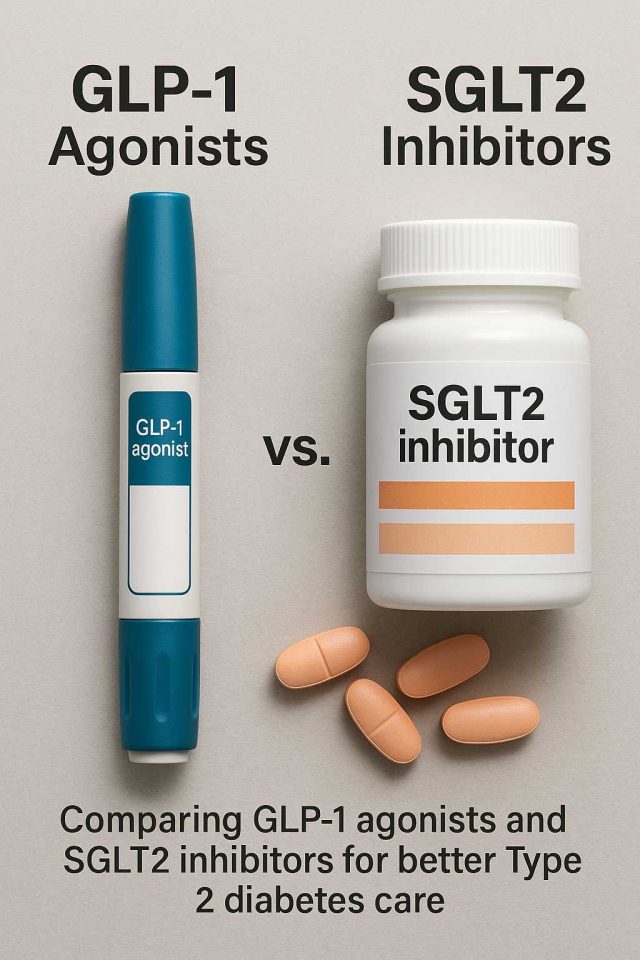Living with Type 2 diabetes often requires more than lifestyle adjustments and metformin. As new therapies emerge, clinicians face a critical question: which modern therapy offers the best outcomes—GLP-1 agonists or SGLT2 inhibitors? This article explores the benefits, risks, and best practices for choosing between GLP-1 Agonists vs. SGLT2 Inhibitors in managing Type 2 diabetes, using evidence-based insights and real-world clinical applications.
Table of Contents
- Understanding GLP-1 Agonists
- Exploring SGLT2 Inhibitors
- Comparing Benefits and Risks
- Best Practices in Clinical Decision-Making
- Conclusion
- FAQs
Understanding GLP-1 Agonists
GLP-1 receptor agonists, such as semaglutide (Ozempic), dulaglutide (Trulicity), and liraglutide (Victoza), have transformed diabetes care. These agents mimic the action of glucagon-like peptide-1, stimulating insulin secretion, slowing gastric emptying, and promoting satiety. For many patients, this leads to improved glycemic control and meaningful weight loss.
One of the standout advantages of GLP-1 agonists is their cardiovascular benefit. Several large-scale trials, including the LEADER and SUSTAIN-6 studies, demonstrated reduced cardiovascular risk in patients at high baseline risk. This makes them an attractive option for individuals with both diabetes and established heart disease.
However, gastrointestinal side effects, such as nausea and vomiting, often challenge long-term adherence. In addition, the injectable delivery method may discourage some patients. Still, with the recent introduction of oral semaglutide (Rybelsus), accessibility has improved. Clinicians now have more flexibility in tailoring therapy to individual preferences and clinical needs.
For healthcare providers, understanding patient goals—whether weight loss, cardiovascular protection, or strict glycemic control—is essential when considering GLP-1 receptor agonists as part of therapy.
Exploring SGLT2 Inhibitors
SGLT2 inhibitors, including empagliflozin (Jardiance), dapagliflozin (Farxiga), and canagliflozin (Invokana), offer a different therapeutic pathway. By blocking sodium-glucose co-transporter-2 in the kidneys, they promote glucose excretion through urine, effectively lowering blood sugar levels.
One of their most compelling benefits lies in renal protection. Studies like EMPA-REG and DAPA-CKD have shown that SGLT2 inhibitors slow kidney disease progression and reduce hospitalization rates for heart failure. This has made them a cornerstone in treating patients with Type 2 diabetes and chronic kidney disease.
In addition to renal outcomes, SGLT2 inhibitors also contribute to modest weight loss and blood pressure reduction. These added benefits often improve overall metabolic health. However, clinicians must remain cautious about side effects, including urinary tract infections, genital mycotic infections, and rare but serious cases of diabetic ketoacidosis.
While GLP-1 agonists may shine for weight management, SGLT2 inhibitors dominate when kidney or heart protection is the priority. This distinction plays a crucial role in individualized care planning.
Comparing Benefits and Risks
When evaluating GLP-1 Agonists vs. SGLT2 Inhibitors, both classes deliver strong outcomes but in distinct ways. GLP-1 agonists excel at weight reduction and cardiovascular protection, while SGLT2 inhibitors lead in renal preservation and heart failure management.
For patients with obesity and high cardiovascular risk, GLP-1 receptor agonists often represent the first choice. In contrast, patients with chronic kidney disease or heart failure frequently benefit more from SGLT2 inhibitors. In some cases, combining the two therapies can yield complementary results, though cost and tolerability remain considerations.
Insurance coverage also shapes prescribing practices. While branded agents like Ozempic, Jardiance, and Farxiga are highly effective, their cost may pose barriers. Patient assistance programs and formulary negotiations often determine accessibility in real-world clinical practice.
Ultimately, understanding the nuances of these therapies allows providers to match the right drug to the right patient. This patient-centered approach enhances adherence, satisfaction, and outcomes.
Best Practices in Clinical Decision-Making
For clinicians, choosing between GLP-1 Agonists vs. SGLT2 Inhibitors requires balancing patient comorbidities, preferences, and clinical goals. A structured approach can simplify this decision-making process:
- Assess cardiovascular and renal status: Patients with heart failure or kidney disease often benefit from SGLT2 inhibitors first.
- Evaluate weight goals: Patients prioritizing weight loss or obesity management may respond better to GLP-1 agonists.
- Consider side effect profiles: Discuss tolerance for gastrointestinal symptoms versus risk of genitourinary infections.
- Factor in delivery preferences: For needle-averse patients, oral semaglutide or SGLT2 inhibitors may be easier to accept.
- Review cost and access: Align prescriptions with insurance coverage to support long-term adherence.
Shared decision-making remains central. When patients are fully informed about the trade-offs, they are more likely to commit to consistent therapy. Resources such as Diabetes in Control articles and Healthcare.pro can further support informed discussions between clinicians and patients.
In addition, external resources like the American Diabetes Association Standards of Care provide updated evidence-based guidance. Integrating these insights ensures clinical practice aligns with the latest research.
Conclusion
Both GLP-1 agonists and SGLT2 inhibitors represent significant advances in Type 2 diabetes care. Their complementary strengths highlight the need for personalized treatment strategies. By considering cardiovascular and renal risks, weight goals, side effect tolerability, and patient preferences, clinicians can craft individualized plans that maximize outcomes.
In practice, the choice is rarely one-size-fits-all. Instead, the art of diabetes care lies in tailoring therapy to the patient, ensuring both clinical effectiveness and quality of life.
FAQs
What are the main differences between GLP-1 agonists and SGLT2 inhibitors?
GLP-1 agonists primarily aid in weight loss and cardiovascular protection, while SGLT2 inhibitors provide strong kidney and heart failure benefits.
Can patients use GLP-1 agonists and SGLT2 inhibitors together?
Yes, combining both therapies is possible and may offer complementary benefits, though cost and tolerability must be considered.
Which therapy is better for patients with kidney disease?
SGLT2 inhibitors generally offer superior renal protection and are recommended for patients with chronic kidney disease.
Are there oral options for GLP-1 agonists?
Yes, oral semaglutide (Rybelsus) is available, improving accessibility for patients who prefer not to use injections.
Do these medications replace lifestyle changes?
No. While effective, both GLP-1 agonists and SGLT2 inhibitors should complement lifestyle interventions, including diet, exercise, and weight management.
Disclaimer
This content is not medical advice. For any health issues, always consult a healthcare professional. In an emergency, call 911 or your local emergency services.
